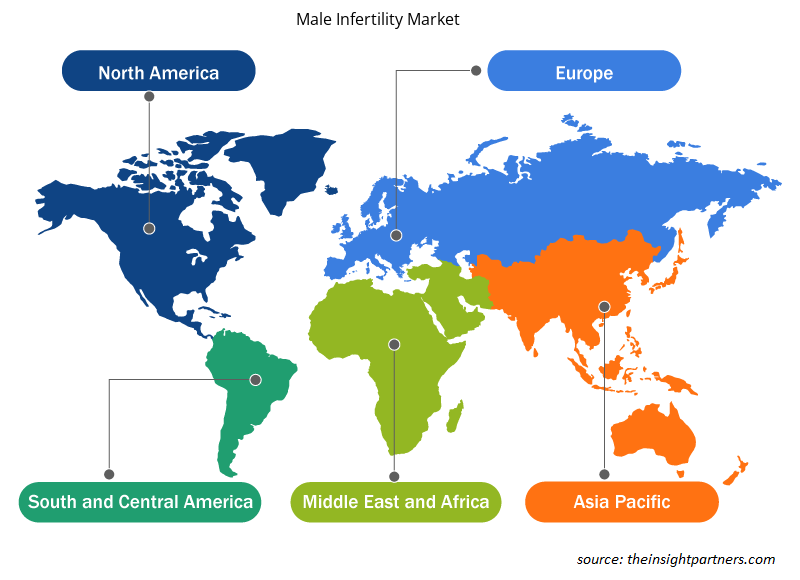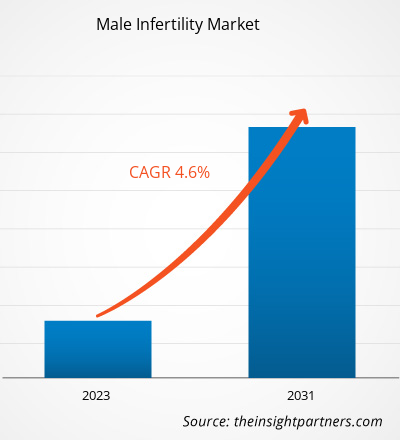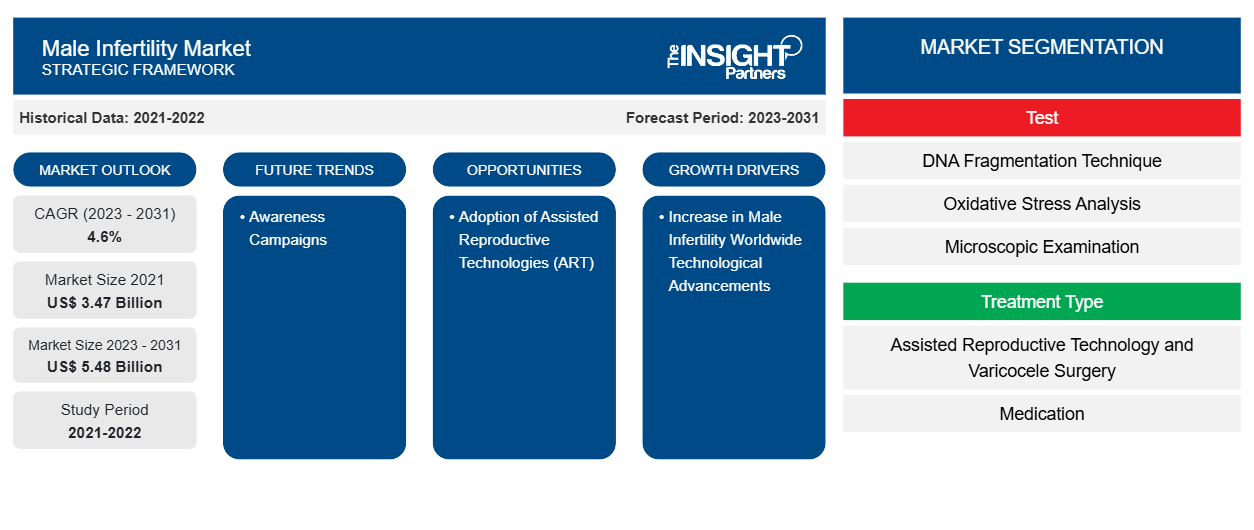El tamaño del mercado de la infertilidad masculina en 2021 se situó en 3.470 millones de dólares y se prevé que alcance los 5.480 millones de dólares en 2031, frente a los XX mil millones de dólares en 2023. Se espera que el mercado registre una CAGR del 4,6 % entre 2023 y 2031. Es probable que la adopción de tecnologías de reproducción asistida (TRA) siga siendo una de las tendencias clave del mercado de la infertilidad masculina.
Análisis del mercado de la infertilidad masculina
El mercado de la infertilidad masculina está creciendo debido a las crecientes tasas de infertilidad, la adopción generalizada de la tecnología de reproducción asistida (TRA) y los avances tecnológicos en TRA, entre otros factores. Además, el aumento de los niveles de estrés, la obesidad, el tabaquismo y el consumo de alcohol son factores que contribuyen a la infertilidad masculina. Además, una mayor concienciación, un mayor gasto en I+D y los cambios en los estilos de vida son factores que impulsan el mercado de la infertilidad masculina.
Panorama del mercado de la infertilidad masculina
La infertilidad masculina es un problema importante en la sociedad moderna. Siempre se ha considerado que la infertilidad es un problema femenino. Sin embargo, los hombres representan casi la mitad de todos los casos de infertilidad. La infertilidad en los hombres es causada más comúnmente por problemas como la disminución del recuento de espermatozoides, la disminución de los niveles de testosterona y el aumento de las tasas de disfunción eréctil y cáncer testicular. Además, se ha descubierto que la contaminación influye en la fertilidad de los hombres, en particular en la calidad del esperma.
Personalice este informe según sus necesidades
Obtendrá personalización en cualquier informe, sin cargo, incluidas partes de este informe o análisis a nivel de país, paquete de datos de Excel, así como también grandes ofertas y descuentos para empresas emergentes y universidades.
-
Obtenga las principales tendencias clave del mercado de este informe.Esta muestra GRATUITA incluirá análisis de datos, desde tendencias del mercado hasta estimaciones y pronósticos.
Factores impulsores y oportunidades del mercado de la infertilidad masculina
El aumento de la infertilidad masculina en todo el mundo favorece el crecimiento del mercado
La infertilidad masculina se refiere a la incapacidad de los hombres para provocar el embarazo en una mujer fértil. La infertilidad suele deberse a factores como la deficiencia en el semen y la calidad del mismo. La infertilidad masculina es un problema de prevalencia mundial con porcentajes que varían de una región a otra. Según un artículo publicado en 2023 por los Institutos Nacionales de Salud (NIH), la infertilidad masculina afecta al 7% de la población masculina mundial. Además, se descubrió que las tasas de infertilidad entre los hombres eran más altas en África y Europa del Este.
Campañas de concientización
La Colaboración Internacional para la Educación en Salud Reproductiva (IRHEC), anteriormente conocida como Iniciativa Internacional de Educación sobre Fertilidad, se creó en 2021. Su objetivo es promover la concienciación sobre la fertilidad a través de la educación. Los materiales educativos que promueven eficazmente la alfabetización o la concienciación sobre la salud reproductiva son fundamentales para tomar decisiones reproductivas informadas y prevenir y controlar la subfertilidad y la infertilidad.
Análisis de segmentación del informe de mercado sobre infertilidad masculina
Los segmentos clave que contribuyeron a la derivación del análisis del mercado de infertilidad masculina son la prueba, el tipo de tratamiento, el canal de distribución y el usuario final.
- Según las pruebas, el mercado de la infertilidad masculina se divide en técnica de fragmentación de ADN, análisis de estrés oxidativo, examen microscópico, aglutinación de espermatozoides, análisis de semen asistido por computadora, ensayo de penetración de espermatozoides y otros. El segmento de técnica de fragmentación de ADN tuvo una mayor participación de mercado en 2023.
- Por tipo de tratamiento, el mercado se divide en tecnología de reproducción asistida y cirugía de varicocele, y medicación. El segmento de tecnología de reproducción asistida y cirugía de varicocele tuvo la mayor participación del mercado en 2023.
- Por canal de distribución, el mercado se segmenta en farmacias hospitalarias, farmacias y droguerías, farmacias online. El segmento de farmacias hospitalarias tuvo la mayor participación del mercado en 2023.
- En términos de usuario final, el mercado se divide en hospitales y clínicas, centros de fertilidad, institutos de investigación y otros usuarios finales. El segmento de centros de fertilidad dominó el mercado en 2023.
Análisis de la cuota de mercado de la infertilidad masculina por geografía
El alcance geográfico del informe del mercado de infertilidad masculina se divide principalmente en cinco regiones: América del Norte, Asia Pacífico, Europa, Medio Oriente y África, y América del Sur y Central.
América del Norte ha dominado el mercado de la infertilidad masculina. El aumento del consumo de alcohol y drogas, el aumento del nivel de estrés, la obesidad, el tabaquismo y las toxinas ambientales son algunos de los pocos factores que se prevé que aceleren el crecimiento del mercado de la infertilidad masculina en América del Norte. Además, se espera que la mayor concienciación y la reducción del nerviosismo entre las personas sobre la enfermedad impulsen la demanda de tratamientos para la infertilidad masculina durante el período de estudio.
Perspectivas regionales del mercado de la infertilidad masculina
Los analistas de Insight Partners explicaron en detalle las tendencias y los factores regionales que influyen en el mercado de la infertilidad masculina durante el período de pronóstico. Esta sección también analiza los segmentos y la geografía del mercado de la infertilidad masculina en América del Norte, Europa, Asia Pacífico, Oriente Medio y África, y América del Sur y Central.

- Obtenga datos regionales específicos para el mercado de infertilidad masculina
Alcance del informe sobre el mercado de la infertilidad masculina
| Atributo del informe | Detalles |
|---|---|
| Tamaño del mercado en 2021 | US$ 3,47 mil millones |
| Tamaño del mercado en 2031 | 5.480 millones de dólares estadounidenses |
| CAGR global (2023 - 2031) | 4,6% |
| Datos históricos | 2021-2022 |
| Período de pronóstico | 2023-2031 |
| Segmentos cubiertos |
Por prueba
|
| Regiones y países cubiertos |
América del norte
|
| Líderes del mercado y perfiles de empresas clave |
|
Densidad de actores del mercado de la infertilidad masculina: comprensión de su impacto en la dinámica empresarial
El mercado de la infertilidad masculina está creciendo rápidamente, impulsado por la creciente demanda de los usuarios finales debido a factores como la evolución de las preferencias de los consumidores, los avances tecnológicos y una mayor conciencia de los beneficios del producto. A medida que aumenta la demanda, las empresas amplían sus ofertas, innovan para satisfacer las necesidades de los consumidores y aprovechan las tendencias emergentes, lo que impulsa aún más el crecimiento del mercado.
La densidad de actores del mercado se refiere a la distribución de las empresas o firmas que operan dentro de un mercado o industria en particular. Indica cuántos competidores (actores del mercado) están presentes en un espacio de mercado determinado en relación con su tamaño o valor total de mercado.
Las principales empresas que operan en el mercado de la infertilidad masculina son:
- Compañía Merck KGaA,
- Sanofi,
- Bayer AG,
- Endo Pharmaceuticals Inc.,
- Diagnóstico SCSA, Inc.,
- Soluciones Andrológicas,
Descargo de responsabilidad : Las empresas enumeradas anteriormente no están clasificadas en ningún orden particular.

- Obtenga una descripción general de los principales actores clave del mercado de infertilidad masculina
Noticias y desarrollos recientes sobre el mercado de la infertilidad masculina
El mercado de la infertilidad masculina se evalúa mediante la recopilación de datos cualitativos y cuantitativos a partir de investigaciones primarias y secundarias, que incluyen publicaciones corporativas importantes, datos de asociaciones y bases de datos. A continuación, se incluye una lista de los avances en el mercado de la infertilidad masculina:
- Sidra Medicine ha puesto en marcha una nueva clínica de infertilidad masculina como parte de su expansión de los servicios privados de medicina reproductiva en Qatar. (Fuente: Sidra Medicine, Sala de prensa, 2022)
- Merck, una empresa líder en ciencia y tecnología, anunció hoy que la Comisión Europea (CE) ha otorgado la Autorización de Comercialización (AC) para su nueva pluma GONAL-f (folitropina alfa) de 150 UI. Esto significa que Merck ahora ofrece una gama aún más completa de las mejores plumas de su clase, que apoyan a las pacientes desde el principio hasta el final de su ciclo de estimulación de la fertilidad, cuando se requieren dosis más bajas. (Fuente: Merck KGaA, Nota de prensa, 2020)
Informe sobre el mercado de la infertilidad masculina: cobertura y resultados
El informe “Tamaño y pronóstico del mercado de infertilidad masculina (2021-2031)” proporciona un análisis detallado del mercado que cubre las siguientes áreas:
- Tamaño del mercado y pronóstico a nivel global, regional y nacional para todos los segmentos clave del mercado cubiertos bajo el alcance
- Dinámica del mercado, como impulsores, restricciones y oportunidades clave
- Principales tendencias futuras
- Análisis detallado de las cinco fuerzas de Porter y PEST y FODA
- Análisis del mercado global y regional que cubre las tendencias clave del mercado, los principales actores, las regulaciones y los desarrollos recientes del mercado.
- Análisis del panorama de la industria y de la competencia que abarca la concentración del mercado, el análisis de mapas de calor, los actores destacados y los desarrollos recientes
- Perfiles detallados de empresas
- Análisis histórico (2 años), año base, pronóstico (7 años) con CAGR
- Análisis PEST y FODA
- Tamaño del mercado, valor/volumen: global, regional y nacional
- Industria y panorama competitivo
- Conjunto de datos de Excel
Informes recientes
Testimonios
Razón para comprar
- Toma de decisiones informada
- Comprensión de la dinámica del mercado
- Análisis competitivo
- Información sobre clientes
- Pronósticos del mercado
- Mitigación de riesgos
- Planificación estratégica
- Justificación de la inversión
- Identificación de mercados emergentes
- Mejora de las estrategias de marketing
- Impulso de la eficiencia operativa
- Alineación con las tendencias regulatorias























 Obtenga una muestra gratuita para - Mercado de la infertilidad masculina
Obtenga una muestra gratuita para - Mercado de la infertilidad masculina